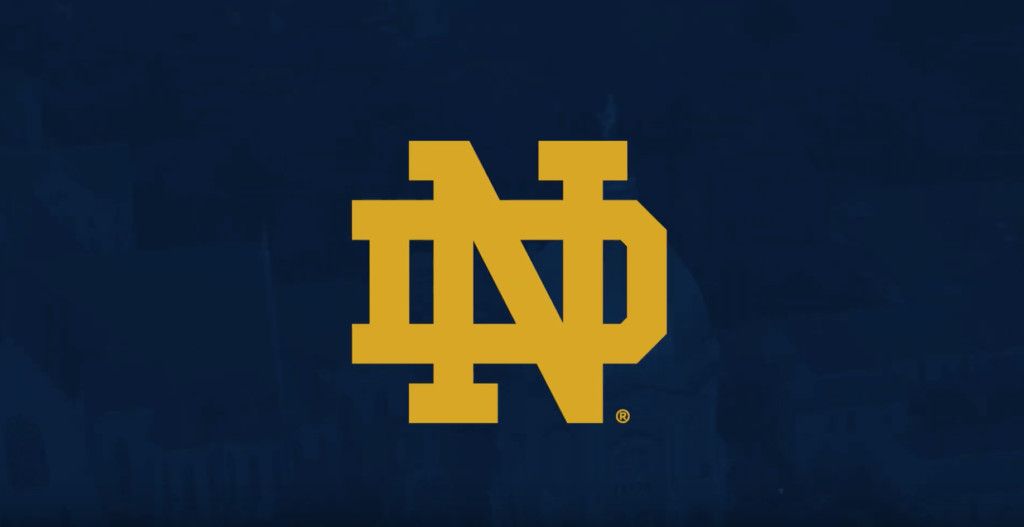May 22, 2001
By Pete LaFleur
Some of the best things in life-and baseball-are worth the wait. And that’s certainly the case with Notre Dame’s dynamic duo of senior righthanders Aaron Heilman and Danny Tamayo, who have emerged as one of the nation’s top pitching tandems in 2001 (look for a sports front-page feature story on the pair in Wednesday’s USA Today).
When Heilman and Tamayo arrived on the Notre Dame campus in the fall of 1997, the Irish baseball coaches began to envision the pair developing into a classic 1-2 punch that would lead the Notre Dame program into a spot among the national elite. As things turned out, they were right … but there were a few big turns that had to be maneuvered before that dream became a reality.
Ultimately, it required Tamayo making a stunning return from “Tommy John” reconstructive elbow surgery while Heilman turned down a lucrative offer from the Minnesota Twins (he was the 31st overall pick in the 2000 Major League draft), instead opting to return for his senior season.
And with those two very large pieces of the puzzle in place, the rest of the 2001 Irish squad has fallen in line while fashioning one of the most accomplished seasons in the 109-year history of Notre Dame baseball.
“Most teams would love to have just one pitcher like Aaron or Danny but we basically have two aces leading the way for us this season,” says seventh-year Irish head coach Paul Mainieri. “With the way college baseball weekend series and the postseason are set up, having two strong starting pitchers is a huge plus for your program.
“Of course, they still have to go out and perform and we’ve had several other pitchers who have helped compile our 46 wins-but there’s no denying how special they truly are.”
DOUBLE TROUBLE
When discussing Notre Dame’s current 1-2 punch, the word “perspective”-along with others such as “focus”, “consistency” and “character”-creep into almost any conversation about the pair.
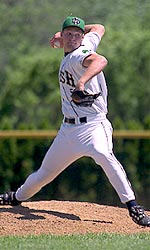
Their statistical numbers are equally staggering. Heilman is a leading candidate for national player of the year, thanks to his 14-0 record (no undefeated pitcher in the country has more wins), a 1.54 ERA (sixth-best nationwide) and 103 strikeouts in 105 innings pitched, plus a .170 opponent batting average and just 27 walks allowed.
Tamayo’s numbers have dipped a bit in recent weeks-he’s now 8-2 with a 2.53 ERA, 101 Ks, just 14 walks and a .217 opponent avg. in 103.1 IP-but he still ranks among the nation’s top 40 ERA leaders and would have been the BIG EAST pitcher of the year if not for his classmate’s dominating season (both were among the three pitchers named first team all-BIG EAST, a first for the league in 16 years).
Tamayo even matched Heilman by throwing three shutouts during the 2001 regular season while holding the edge in BIG EAST player-of-the-week honors (three to two). Heading into the final home weekend, Tamayo actually owned the better season ERA (1.42 to 1.43) and had 78 Ks to Heilman’s 76.
And when they were paired in BIG EAST doubleheaders this season, it was all but automatic for the Irish-who outscored the opponents 95-27 while winning all 14 of the duo’s back-to-back outings (Tamayo had one no-decision). Their combined stats in those 14 games included a 1.81 ERA, 10 complete games, four shutouts, 105 Ks, 21 walks and 69 hits allowed in 104.2 innings (for nine-inning averages of 9.0 Ks, 1.8 BB and 5.9 H).
That dominance by ND’s dynamic duo often can lull their teammates to sleep.
“Sometimes, it can work to our disadvantage as hitters because we get complacent and think we only need a few runs,” says Irish tri-captain and junior third baseman Andrew Bushey.
“But they are a perfect combination as a 1-2 punch. Aaron starts off by coming hard at you with all of his pitches and then Danny goes out there and starts hitting his spots with such great efficiency. It can’t be a fun day as a hitter to face that combination in one day.”
Heilman and Tamayo’s overall combined statistics in 2001 include a 22-2 record and 2.03 ERA, plus 204 Ks (8.8/9 IP), 41 walks (1.8), a 5.0 K-to-BB ratio, 15 complete games, 6 shutouts and nine-inning averages of 6.3 hits and 10 groundouts.
SIMPLY THE BEST
Heilman-who is slated to start Friday’s opening game versus Wisconsin-Milwaukee in the NCAA Championship South Bend Regional-continues adding to what will be a four-year All-America career (one of just five ever posted by a Notre Dame athlete playing in a team-oriented sport). That four-year odyssey began with a bang in a 1998 season that saw him fashion a 33-inning shutout streak while leading the nation in ERA (1.61) as a freshman closer. He followed up a strong sophomore season by being one of the top pitchers on the 1999 U.S. national team (a staff that included current USC ace Mark Prior, UCLA’s No. 1 Josh Karp and crafty Stetson lefthander Lenny Dinardo) and he heads into the NCAAs with victories in 24 of his last 25 decisions.
The BIG EAST career leader in conference wins (23-4), strikeouts (199) and complete games (18), his 42-7 career record and 417 strikeouts make him a member of an exclusive club of all-time Division I college baseball pitchers who have totaled 40 wins and 400 Ks. The 400-40 club is known to include just 15 members, with Heilman, South Carolina’s Kip Bouknight and Rice’s Kenny Baugh becoming the first players since 1994 to join that elite group (each reached the milestones this season).
The list goes on and on-the first ND pitcher ever to start a season 11-0, an 18-K game last season at West Virginia that tied the BIG EAST record (he K’d 10 of the final 12 he faced), a 13-1 career record on the opponent’s field, etc.-but the achievements never grow old:
- His most noteworthy entries in the Notre Dame record book include the career strikeout record (leading former recordholder David Sinnes by 98 Ks) and the program’s top three season K totals (118, 118 and 103 the past three years) while his 14 wins and 11 complete games in 2001 are tied for Irish single-season records. Heilman’s 25 career complete games are the most by an ND pitcher since Norwood Gibson’s five-year career ended in 1900 (with 28 CGs) while his 2.46 career ERA is best by an Irish pitcher during the aluminum bat era and best since Nick Palihnich’s 2.36 from 1959-61.
- Most coaches would be overjoyed with a pitcher who is allowing just a .212 opponent batting average-but that’s the number that represents Heilman’s opponent slugging percentage for 2001 (12 doubles, just two home runs), equating to just 2.1 total bases per every 10 opponent at-bats (he has averaged 32 innings per home run allowed in his career).
- He still has a shot at becoming the first Division I player ever to lead nation in ERA twice, with Southeast Missouri’s Todd Pennington currently sitting atop the list at 1.33. One of other pitchers ahead of Heilman on that list is USC’s Prior (1.49), who potentially could face his former USA teammate if the Irish and Trojans both advance to the superregional round.
- A typical nine-inning stint from Heilman is 2001 has included nearly 20 of 27 outs via the strikeout (8.8) or groundout (10.8) while his season K-to-walk ratio has swelled to nearly 4-to-1.
- Runners on base have done little to affect his opponent batting average in 2001 (.170 overall, .169 with runners on) while two-out rallies have been few and far between-as he’s allowed just 15 two-out hits and .126 opponent batting with two outs in 2001.
- Rutgers remains the only team ever to beat Heilman twice during his Irish career-but he beat the Scarlet Knights twice this season in high-pressure games. He is 11-1 overall when facing a team that beat him earlier in his career (avenging all of his losses aside from his lone non-conference defeats, to Florida International and Ohio State).
FOR THE LOVE OF THE GAME
Tamayo’s upbringing as the son of a Cuban exile revolved around a daily love for the game of baseball. His father Ignacio, or “Iggy,” coached Danny (whose given name is Ignacio VI, with the middle name of Daniel) and his two younger brothers during their junior high days and baseball always has been a hot topic in the Tamayo household.
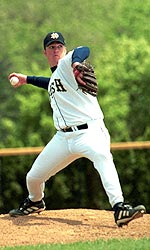
“There will be times when we all get back together and the conversation turns to baseball, how one of the boys is trying a new grip for a pitch or something like that,” says the lone female in the family, mother Carla. “Then someone will go and get a ball and we’ll have a big discussion. We just all love the game of baseball and it means a lot to our family.”
The eldest Tamayo boy was hooked on baseball as a two-year-old, often pulling his mother into the backyard to lob a few more pitches at his oversized whiffle-ball bat before she hurried off to work.
That passion for sports is easy to trace, as Ignacio IV-Danny’s grandfather, who is expected to be in attendance at this week’s South Bend Regional-was an accomplished athlete in his native Cuba, with his time of 4:16 in the 1,5000 meters holding up as the national record for some 30 years. The proud grandfather-now 78 and an avid internet listener of every Irish baseball game-also was a standout performer in water polo, swimming and basketball before leaving Cuba for the United States in the 1960s (the Tamayo’s have called Miami home since 1975).
Iggy Tamayo was eager to pass along the same love of sports to his children that his father had bestowed upon him. He and Carla-a native of Idaho who had moved to Miami-soon discovered that their eldest son (whom they call Daniel, pronounced “Dan-ee-l”) was destined to be a top-level pitcher. But he had to grow into that role.
“Daniel was playing a game when he was seven or eight years old and he came to bat with the game on the line and he had the big hit,” recalls Iggy, who readily classifies himself as part of the unique subculture of true baseball fanatics. “But after the game he told me, `Popie, my knees were shaking because I was so nervous.’ I just told him that he should never again be nervous in those situations but instead he should be excited. And that’s the type of pitcher he has become. He has fun when there’s pressure.”
Tamayo’s first venture into organized baseball came at the age of four, on a tee-ball team comprised mostly of five- and six-year-olds. As he progressed through the little league ranks, the future Notre Dame star began to hone his craft on the mound, with his biggest asset coming between the ears.
“When I go to the games, I often am yelling words of encouragement to Daniel but he always has said that he can’t hear us when he’s out there on the mound,” relates Iggy, who also coached current Florida Marlins third baseman Mike Lowell at Epiphany Catholic School (Lowell’s father Carl preceded Iggy as Epiphany’s coach and was tutored in his youth by Iggy’s father).
“He has become so mentally tough that he tunes everything out and focuses on putting those pitches where he wants them to go. If I had one word to describe him-as a kid and now as a young man-it would be poise. And that’s what gives him that knack for being at his best in tough situations.”
PRIME-TIME PERFORMANCE
Tamayo’s coming-out party occurred in just such a pressure-filled situation, when he shocked host Mississippi State with a three-hit shutout at the 2000 NCAA Starkville Regional. But he almost didn’t even pitch in the regional, with the Irish rallying the night before to beat Tulane after a lengthy tornado delay. Tamayo actually was warming up in the bullpen when the game was halted, forcing him to sprint to the dugout as debris went flying around Dudy Noble Field. Irish closer John Corbin’s heroic five-inning performance saved the day and Mainieri then handed the ball to Tamayo for a game that was set to start in less than 12 hours.
The night before the MSU game, Tamayo gave his father one of his game hats and it’s been with his dad ever since. “That night he came and talked to me and you could tell how excited but also how at peace he was,” remembers the elder Tamayo. “He knew that he was about to do something special.”
Tamayo-whose 105-pitch gem represented just the second shutout ever posted by Notre Dame in NCAA tournament play-carried a no-hitter into the seventh inning and faced just 30 batters (with no walks and one strikeout) while effectively taking the raucous crowd of 10,000-plus out of the game.
“That performance speaks volumes for the character of the kid,” says seventh-year Notre Dame pitching coach and recruiting coordinator Brian O’Connor. “You can have the most talent in the world but you still have to go out and do it.
“He was fearless vs. Mississippi State and was not to be denied. And he was not going to come out of that game. He had a very low pitch count and was just dominating. But it didn’t surprise me because he has such great character. He’s very calm and before the game gets really focused.”
For Tamayo, the key to his success was a simple one. “I just went out and pitched my game,” he says. “I pitched to my strengths.”
IN COMMAND
The strengths that carried Tamayo that day in Starkville likewise have been evident for most of the 2001 season, with the added boost of improved all-around control.
“He’s most improved with his command of his fastball and throwing multiple pitches for strikes on any count,” says O’Connor, whose Irish staff led the nation in ERA for three weeks during the 2001 season (now third at 3.07). “Even though he doesn’t have an overpowering fastball, he’s got what it takes to win at the Major League level.”
Mainieri most admires Tamayo for the ability to consistently “set pitchers up and put ’em away” while Tamayo credits his consistent success to the gradual process of returning to fulltime pitching.
“I didn’t really have a curveball as a freshman or even last season, but now it’s a pitch that I consistently can mix in for strikes,” he says. “Also, because I’m stronger and more effective now, I can do things I couldn’t do before, like working up in the zone and that just gives you more options of keeping the hitters guessing and swinging at pitches.”
The most reliable statistic from Tamayo’s final stat line in each outing is a low walk total.
“I just can’t stand walking people at all. I feel like I should never walk a guy,” says Tamayo, whose 2001 season includes an average of just 1.2 walks per nine innings (with no walks in four games and just one in seven others). He has posted a career-high 10 Ks in five different games this season while totaling just three walks in those games, including a three-game stretch in which he racked up 30 Ks and walked just one batter.
THE LONG ROAD BACK
The first month of Notre Dame’s 1998 season included five relief appearances by the promising Tamayo, whose rookie season-and his second year, for that matter-effectively came to an end when he injured his elbow on March 1, 1998. It would a full 12 months before the Tamayo’s opted for the final resort of “Tommy John” reconstructive surgery and another year would pass before Tamayo finally registered the sixth appearance of his suddenly uncertain college career.
Two years and one week after injuring his elbow in a win over Indiana, Tamayo was given the nod to enter a game versus Manchester College. Months of painful rehabilitation and lingering doubts-coupled with an undying drive to succeed-produced a rush of energy that practically vaulted the Irish pitching staff’s “forgotten man” from the dugout onto the pitching mound.
“I sprinted out to that mound and was just so excited to finally be making it back,” recalls Tamayo, who faced four batters to close the ninth inning of that 5-1 win, before being mobbed by his teammates. “Still, I knew that was just one day in the process. I’d been through a lot, but it was by no means over.”
Despite seeing most of his freshman season wiped out by injury, Tamayo clung to the belief that he could rehabilitate his arm and develop into the team’s No. 3 starter in time for the 1999 season. But lingering pain led to the diagnosis of a torn ligament in his pitching elbow and surgery followed in March of 1999.
The procedure-named for the former Major Leaguer-involved taking a tendon from Tamayo’s left wrist and inserting it into his right elbow. And while the surgery traditionally has met with mixed results-former Irish pitcher Larry Mohs returned from Tommy John surgery to become ND’s closer in 1997-the success rate for Tommy John procedures continues to grow, with many patients coming back noticeably stronger.
The fall of 1999 would prove to be a pivotal juncture in Tamayo’s comeback. After enduring six months in which he didn’t even pick up a baseball, the clever righthander began rediscovering himself as a pitcher.
“When I was hurt, I just was trying to focus on what would make me the best possible pitcher when I came back,” he says. “I worked on my body and tried to develop a real solid motion. There was a focus on things like staying back, following through, using my legs. Mentally, I was ready to go.”
O’Connor does little to downplay the impact of how Tamayo spent his down time.
“Danny handled the time off-the injury, the surgery, the rehab-great. That’s the reason he is so good now,” says O’Connor. “He really concentrated on working on his mechanics. After the surgery, he’d go down to the bullpen and go through his mechanics. He’d use his arm without actually throwing a baseball. That helped disguise his changeup and has allowed him to stay healthy during the past year, because now there’s no undue strain on his arm.”
After missing out on the spirited team atmosphere during his rehabilitation time, Tamayo gradually worked back into shape and emerged as a noticeably different pitcher. When he came off the mound, his whole body ached and not just his arm-“so I knew that I was throwing the right way by using my whole body, my legs and my back,” he says.
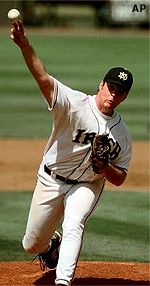
Tamayo’s entire rehabilitation process was overseen by the careful guidance of athletic trainer Mike Bean, now in his 10th year with the ND baseball program.
“The injury gave Danny a new perspective. It gave him the chance to rededicate himself and discover his full potential as a pitcher,” says Bean. “The loss of the ability to do something you love can really put things into perspective.”
A series of strengthening exercises coaxed Tamayo’s right elbow back into shape and his regimented schedule as a starter has helped to maintain that progress.
“It’s always a question mark as to whether a pitcher can come back from surgery like that or be as effective. But he had a great attitude and worked hard to get where he is now, ” says Bean.
“He hit the wall a few times and had to work through some soreness that was required to get rid of the scar tissue. We had to tell him that he was not going to be 100% right away and would have to pitch through some of that soreness in order for it to go away.”
But the deepest scars may have been caused by periodic feelings of isolation. “The worst part of it all was feeling like you weren’t part of the team,” says Tamayo, who rates as one of the top card players on a squad that carries its own cribbage board on road trips.
“We travel a lot and when you don’t go on the trips you miss out on a lot. It wasn’t the fault of anyone else, that’s just the way it was. I also was not practicing, so I was really out of the circle of the team.”
Despite the injury-forced detour in his career, Tamayo does hold a spot in the NCAA record book-albeit a very dubious one. As a freshman, he returned to his hometown of Miami and served up two grand slams in the same inning of a game versus his hometown Hurricanes. “That game still motivates me,” he says. “Some people, that’s all they know about me … I’d love to have the chance to pitch against Miami again.”
Tamayo admits to often wondering how his career may have been different-for better or worse-without the injury. “Maybe I wouldn’t have reached the level of success that I’ve enjoyed without the surgery, but maybe I would have pitched just as well and had more time to pitch,” says Tamayo, who still regularly does strengthening exercises out of fear that his forearm would go weak. “All I can focus on now is making myself a better pitcher in my present situation.”
HOMEGROWN
Like his classmate, Heilman grew up in a closeknit family but-unlike Tamayo-he was the youngest of three children and the only boy.
“Aaron grew up idolizing his two sisters. He never wanted to be better than them in sports and other activities-he just wanted to do whatever they did,” said Joe Heilman, who has seen nearly all of his son’s home games, even when Aaron is not pitching.
The Heilman’s can’t help but chuckle when remembering a span of 20-some days when two of their children turned in impressive outings on the diamond.
“There was this one time when our daughter Michelle pitched a no-hitter and Aaron wanted to do it too,” recalls Joe Heilman. “Again, he didn’t mean to do it but Aaron ended up throwing a perfect game a couple weeks later. He would’ve been fine with just the no-hitter.”
Joe Heilman was tipped off early on that his son was destined to be a ballplayer. “I used to take him with me to my softball games and we were in the outfield one day and a linedrive hit Aaron in the head,” recalls the elder Heilman.
“I thought that could be the end of his attraction to baseball, that he might be afraid of the ball. But he just shook it off and told me that he hoped he could throw that hard someday. He’s been that same type of kid ever since he was nine years old.”
WAITING GAME
Heilman’s 1999 summer season with Team USA coincided with a two-month stretch for Tamayo in which he was uncertain what the future would hold. Those roles would be released in the summer of 2000, as a renewed Tamayo headed off to pitch in the Alaska League while Heilman returned home for his own period of newfound perspective.
For the first time in as long as he could remember, Heilman was not a part of team baseball. He spent the summer in Logansport with his family, wondering every day what his future would hold and what decision he ultimately might make.
“It was hard at times, not playing during the summer and having that decision hanging over me head,” he says. “But I just tried to recharge my batteries, got refocused and kept everything in perspective. It was just another decision I had to make, like picking where to go to college.
“It wasn’t a decision about money or school. It was a life decision.”
As the summer wore on, the likelihood of Heilman not signing with the Twins grew-if even by small percentages (many college players sign at the last minute). But with a scholarship still waiting for him back at Notre Dame and a talented team set to return, Heilman opted to delay his professional career and returned for his senior season with the Irish.
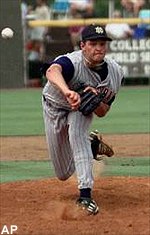
“We were so proud of Aaron for the way he handled himself during the entire decision-making process,” says Joe Heilman. “He always has tried to be an honest and straightforward person and it was his decision to make. His word means more than any dollar amount and it obviously meant quite a bit to him to come back to Notre Dame.”
After passing on “bonus bucks” for a bonus year as a college student, Heilman tried to make the most out of his final days as a Notre Dame undergraduate. He soaked in the atmosphere of Notre Dame football weekends and spent quality time with his teammates and other friends from outside the team.
“One of the great things about Notre Dame is that they don’t stick all the athletes with other athletes when you come in as freshmen,” says Heilman. “This year I lived with three guys who aren’t student-athletes. I just think it’s good to meet a wide variety of people because it helps you develop as a person. It also gives you the chance to step away from the game for a while and just enjoy being a college student.
“I’ve never once regretted my decision to come back and I couldn’t have asked for anything more … except for a College World Series ring.”
Adds O’Connor, “Aaron went through the whole experience with the pro scouts last season and he’s all the more wiser for it this year. He knows he doesn’t have any control over the (draft) situation, aside from trying to do his best to help this team win. And he’s pretty good at doing that.”
THE BIGGEST DOMINO
Heilman’s decision to return set off a chain reaction in the Irish pitching staff, allowing Tamayo and others to ease into roles where they have excelled for most of the 2001 campaign.
“Aaron coming back has allowed me to settle in at the No. 2 spot. It would have been a much tougher challenge to be that No. 1 starter every week,” says Tamayo.
“I’ve learned a lot about pitching and other intangible things by throwing after Aaron for most of this season. I really admire how competitive he is on the field and so laid-back off it. People would never know he’s one of the best pitchers in the country if they walked into the lockerroom and heard him telling one of his bad jokes or trying to stump you with some sort of riddle. But that’s who he is and it’s totally genuine.”
Heilman likewise has developed an admiration for Tamayo’s impact on the 2001 season. “The biggest thing you notice about the guy is his perseverance. Throughout all that rehab, he never questioned himself and always had the winner’s mentality,” says Heilman.
“Combining with Danny this year has been a great experience because you don’t have to worry about being perfect every day. I love watching him pitch because he prepares for a game like it’s a war-and that just makes me step up my game even a little more.”
Sophomore J.P. Gagne-who has emerged to claim the No. 3 starter role in each of the past two seasons-likewise was impacted by Heilman’s return, as Gagne opened the season in a swingman-type of role before reclaiming a weekend starter spot at midseason.
“Having Aaron and Danny start off the weekend has made things easier for me, just by watching how they approach different batters and how they get them out,” says Gagne. “They both are such great competitors and have taught me a lot about how to pitch effectively on the college level.
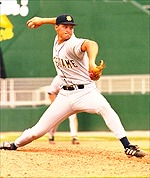
With Heilman and Tamayo leading the way, the Irish truly have been a tough team to beat throughout the 2001 campaign.
“As a teammate, if you don’t want to go out and battle as hard as you can to for guys like Danny and Aaron, then something is wrong,” observes O’Connor, who pitched in the College World Series during his career at Creighton. “With the sacrifices and challenges that they each have faced and considering what great leaders they are for this team, you can’t help but want to help guys like that be successful.”
THE TEACHER
O’Connor’s influence on the rise of Heilman (just a 54th-round draft pick out of high school) and Tamayo (undrafted as a prep) into legitimate Major League prospects is nothing new, as he helped Brad Lidge develop into a 1998 first-round selection (he was a 42nd-round pick out of high school) while molding undrafted prep lefthander Tim Kalita into a seventh-round pick in the ’99 draft.
“He’s such a great pitching coach because he tailors his style to different guys,” says Tamayo of O’Connor. “He doesn’t have a style that he imposes on you and just wants each guy to get the most out of his ability.
“He can tell you something that you are doing wrong and it really gets you focused and makes you a better pitcher. He also doesn’t overcoach and is focused in on the mental aspect of the game more than any coach I’ve ever known.”
O’Connor made an important impact on Tamayo during the season-opening loss to New Orleans, when an errant pickoff throw from the Irish righthander came at a crucial juncture and helped UNO surge into the lead.
“Coach O’Connor told me during that game that you can be pitching a great game and then-all of a sudden-one mistake and we’re losing the game,” says Tamayo, who won his next eight decisions after that opening setback. “Ever since that game, I always come out every inning and tell myself not to lose my focus.”
O’Connor likewise has helped oversee the expansion of Heilman’s pitch repertoire to include his patented darting slider and-most recently-an effective split-finger fastball that has helped improve each of the All-American’s offerings.
“The split-finger has made all of Aaron’s other pitches better, there’s no question,” says O’Connor. “His strikeouts might have seemed down at times this season but that’s probably because a lot of hitters are just trying to make contact-and you see that in all the groundballs and popups that he gets.”
SUPPORT SYSTEMS
Tamayo is thankful for being given a second chance and for receiving the high level of care at Notre Dame.
“I feel extremely fortunate to have been at such a special place as Notre Dame when I was facing some rough times,” says Tamayo. “Of course my parents were a great support in so may ways-my dad even would cut out articles about guys who came back from Tommy John surgery and send them to me. There’s also a great support system here at Notre Dame, on the baseball team and in the school in general.
“A big reason for where I am now is Mike Bean. He put in the time with me and he was the catalyst. It’s tough to say if I’d have done it without him.”
Heilman had his own family crisis during his freshman season, when his father had to undergo major surgery. “We are so indebted to coach Mainieri for letting Aaron come home at times during that first season,” says Joe Heilman. “He let Aaron shift around his workouts and that meant so much to our entire family.”
The younger Heilman recalls discussing his father’s condition with Mainieri “but it felt just like I was talking to a family member-he was so understanding and concerned.”
FINAL CHAPTER
As the Notre Dame season heads for the NCAAs, the evolution of the Heilman-Tamayo combination likewise is nearing its end-prompting O’Connor to reflect on his first impressions of the pair-and his present observations.

“We thought that Danny was going to be an outstanding pitcher when we recruited him, because he was a kid who really knew how to pitch,” says O’Connor. “And you could tell that there was something special about Aaron. In challenging situations, he would raise his game up. I can’t say that I projected him as being a four-year All-American, but definitely had that mound presence and was a very humble, yet confident, kid.
“If you know anything about college baseball, how can you not be impressed with the four-year career that Aaron Heilman has put together? You’d be hard-pressed to find any pitcher who has squeezed more success-and meant more to his team-during each of his four seasons. He just keeps getting better and better.”
The four-year averages of Heilman’s career are testament to that dominant consistency: 9.8 strikeouts per nine innings pitched, just 2.6 walks per nine innings, a .200 career opponent batting average and nearly a 4-to-1 K-to-walk ratio.
According to O’Connor, Heilman’s legacy will be his ability to consistently “raise his game when the team needs him, whether it be after falling behind in the count, or finding himself in a tough jam with runners on base or holding the score in a tight game-there are things that he’s done all through his career. They also are things that you can’t teach to a college pitcher. It’s something he developed as a kid growing up and the credit goes to his parents. I have a lot of respect for them and how they raised their son.”
Heilman “raised his game” twice this season in a pair of matchups with BIG EAST rival Rutgers. With the league lead hinging on an early April series at RU, the Irish faced a 2-1 deficit after four innings in the seven-inning opener.
“Aaron came running to the dugout and told the offense to just get him a couple of runs and the game would be over,” says O’Connor. The offense came through, as did Heilman, and that 10-2 win propelled the Irish to the first three-game sweep at Rutgers ever by a BIG EAST opponent.
Heilman added a nine-inning display of domination versus Rutgers in a BIG EAST Tournament elimination game last week, taking a perfect game into the seventh inning. He allowed just one ball to leave the infield in the first six innings and went on to post 12 strikeouts, 10 groundball outs and three infield popups in the 6-2 win.
ON TO THE FUTURE
An fitting final note on Heilman and Tamayo is the fact that each of their fathers placed a priority of instilling a sense of respect in their sons at a young age. Now, as they near postgraduate life (Tamayo has a fifth year of eligibility available to him), the senior leaders are on the receiving end of widespread respect.
“One of the keys to Danny’s success was that he always kept things in perspective, no matte how tough things got for him,” says Irish senior utility player Ben Cooke. “He realized how fleeting things are and that made a big impact on him.”
In a recent conversation with his son, Iggy Tamayo advised Daniel to “enjoy these times because they are the best years of your life,” to which the younger Tamayo replied, “You don’t have to tell me, popie, I already know.”
Early in the 1998 season, Heilman and Tamayo saved each other’s victories. Many thought it was the sign of great things to come for the pair but none could have predicted the unique road that each was to travel during the ensuing four years. But through it all, Notre Dame’s dynamic duo has maintained its perspective.
“What I keep telling myself is that it’s still only baseball,” says Tamayo. “I’ve had a lot more important things happen to me in my life, so I’m just having a lot of fun and try to put the game in perspective. Why should I put more pressure on myself? I worked hard to get back to this point, so I might as well enjoy it.”
With plenty of others joining in as well.







